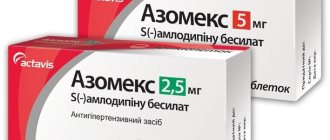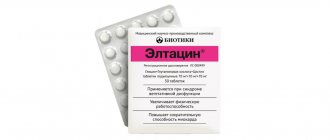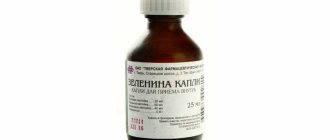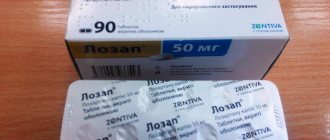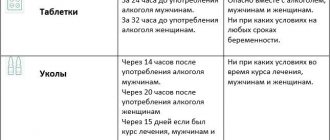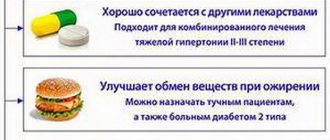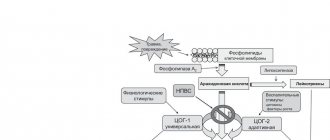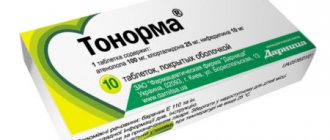Instructions for use of the drug
"Anaprilin" belongs to a group of blockers of adrenergic receptors located in different parts of the human body: blood vessels, muscles of the heart, bronchi, uterus and prostate gland.
The interaction of the drug with sensitive cells prevents the stimulating effect of the nervous system and endocrine glands, which explains its use for idiopathic tremor and endocrinological diseases. In cardiological practice, the drug is most often prescribed to patients with coronary heart disease. The active substance helps reduce the myocardial oxygen demand and prevents remodeling (restructuring) of the heart muscle. The drug has been proven effective in reducing mortality when taken in the first hours after a heart attack.
Indications: what does the medicine help with and when is it used?
The multidirectional effect of the drug on the structures of the body determines its widespread use in medical practice. The instructions for use of "Anaprilin" highlight the following indications for prescribing the medication:
- Essential (primary, idiopathic) arterial hypertension is a disease accompanied by persistent excess of standard pressure values for no apparent reason;
- coronary heart disease (CHD) – a pathology characterized by impaired blood supply to the myocardium with typical pain in the chest during physical activity;
- angina pectoris – a chronic form of coronary artery disease;
- hypertrophic cardiomyopathy – a pathology characterized by the proliferation of muscle fibers, which reduces the volume of the chambers of the heart;
- rhythm disturbances: atrial flutter or fibrillation (atrial fibrillation), supraventricular tachycardia, extrasystoles;
- pheochromocytoma - a tumor of the adrenal tissue that synthesizes catecholamines (adrenaline, norepinephrine);
- essential tremor - “trembling” of the hands or other parts of the body for no apparent reason, familial cases are more often recorded;
- alcohol withdrawal is a complex of disorders caused by abstinence in people with alcoholism;
- infantile hemangiomas - benign tumors of the vascular wall (more common in children);
- diffuse toxic goiter and thyrotoxicosis of another etiology (against the background of thyroiditis) are diseases of the thyroid gland, accompanied by increased synthesis of hormones. "Anaprilin" is prescribed as a second-line drug.
In addition, the product is used to prevent migraine attacks, panic attacks and deep anxiety.
Directions for use: how to take?
The regimen for using “Anaprilin” is determined by the person’s age, disease and severity of the pathology. The average therapeutic doses and frequency of administration of the drug are presented in the table.
| Disease | Form | Dose (in milligrams) | Multiplicity |
| Arterial hypertension | Tablets, capsules | 40 | 2 times a day (if ineffective, increase to 4) |
| Angina pectoris, arrhythmias | Tablets, capsules | 20 – 2 weeks, followed by an increase to 40 | 3 times a day |
| Post-infarction state | Tablets, capsules | 80 | 3 times |
| Paroxysmal arrhythmias, thyrotoxic crises | Solution for intravenous administration | 1, after 2 minutes - again | If there is no effect, inject up to 10 times under control of the rhythm and pressure level |
| Migraine | Pills | 40 | 3 times a day |
In obstetric practice, Anaprilin is used to stimulate the onset of labor and prevent hypotonic bleeding in the postnatal period. The dose of the drug is 20 mg 3 times a day for 3-5 days.
The drug should be stopped gradually due to the risk of developing rebound syndrome (progression of symptoms of the underlying disease). The dose used is reduced by 25% every 3-4 days until complete withdrawal.
Composition and release form
"Anaprilin" (active ingredient - propranolol) is a drug that is used for long-term use and emergency care, therefore, for convenience, it is available in different forms.
| Release form | Dose of Propranolol |
| Pills | 10 and 40 mg |
| 0.25% solution for intravenous administration 1 mg | 2.5 mg per ampoule |
| 1% solution – 5 ml | 5 mg per ampoule |
| Long-acting depot capsules, taken once a day | 80 mg |
Mechanism of action: how quickly and for how long?
Propranolol is a non-selective (no selective effect on the cardiovascular system) beta-blockers without internal sympathomimetic activity, which causes a wide range of therapeutic effects:
- Decrease in heart rate (due to the effect on receptors in the myocardium).
- Reducing the oxygen demand of the heart muscle (this is how the antianginal effect of the drug is realized).
- Decrease in total peripheral vascular resistance (with long-term use). In the first 2 weeks, there is an increase in the tone of smooth muscle fibers, respectively, in diastolic blood pressure, followed by stabilization and decrease.
- Increased tone of smooth muscles of the bronchi (bronchospasm) and uterus (stimulation of labor).
- Depressive effect (the drug penetrates the blood-brain barrier and has a direct effect on centers in the brain).
- Slows down the processes of iodine metabolism in the body (inhibitory effect on the thyroid gland).
- Hypoglycemic effect: blockade of receptors reduces the counter-insular effect of adrenaline and contributes to a drop in blood glucose levels (one of the contraindications of the drug is diabetes mellitus).
"Anaprilin" belongs to the group of lipophilic beta-blockers, which are quickly and in high concentrations absorbed from the gastrointestinal tract. In the blood they combine with proteins: 95% of the drug is in bound form. The drug begins to act after 1 hour (when taking tablets), reaching its maximum concentration within 2 hours.
The duration of the effect of tableted “Anaprilin” is 4-6 hours, which determines the frequency of administration of the drug.
Metabolism and excretion processes occur in the liver, therefore, in patients with dysfunction of the hepatobiliary system, smaller doses of the drug are recommended due to the risk of accumulation and overdose. Less than 1% of the drug is excreted by the kidneys.
Side effects and symptoms of overdose
Undesirable consequences of using “Anaprilin” are associated with the accumulation of active metabolic products or intake against the background of contraindicated conditions:
- orthostatic hypotension – a drop in blood pressure when changing position from horizontal to vertical;
- bradycardia (decreased heart rate): frequency reaches 40-50 per minute;
- allergic reactions: itchy rash, swelling;
- blurred vision (due to decreased secretion of the lacrimal glands);
- dry tongue, nausea, vomiting, pain in the upper part and bloating, diarrhea;
- redness of the skin, hair loss, the appearance of psoriasis-like peeling;
- collapse - a decrease in vascular tone in the arteries of the brain with loss of consciousness;
- muscle weakness and numbness of the limbs;
- nasal congestion, broncho- or laryngospasm;
- hypoglycemia (in patients with diabetes mellitus, propranolol prolongs and enhances the effect of insulin);
- headache, weakness, increased fatigue;
- sleep disorders (insomnia or pathological daytime sleepiness);
- conduction disorders: atrioventricular block.
If your health worsens and side effects occur, you should stop taking the drug and consult a cardiologist.
Main symptoms of poisoning:
- dizziness;
- severe bradycardia and drop in blood pressure;
- loss of consciousness;
- difficulty breathing (noisy exhalation);
- cyanosis of fingers and toes (in children - faces);
- convulsions;
- on the electrocardiogram: conduction disturbance in the AV node, frequent ventricular extrasystoles.
The toxic dose is individual for each person, depending on the state of the liver enzyme system and the presence of concomitant diseases. In most cases, symptoms of poisoning develop with the simultaneous use of more than 1 gram of the drug.
Alcohol compatibility
According to the instructions for use of the drug, drinking alcohol while taking Anaprilin is not recommended. Toxic exposure occurs due to:
- damage to liver enzyme systems by ethanol metabolism products, disturbances in the processes of metabolism and excretion of the drug;
- additional inhibitory effect on the central nervous system;
- alcohol causes tachycardia and increased blood pressure, which neutralizes the effect of Anaprilin;
- increased side effects of the medication (headache, weakness, nausea).
Compatibility of the drug with other substances that affect the nervous system – increased depressive effects.
Indications and contraindications
Anaprilin helps reduce myocardial ischemia, which minimizes the risk of developing a heart attack, and after a heart attack has already occurred, reduces the risk of mortality. By taking the tablets, you can eliminate vascular headaches, tremor, and other unpleasant symptoms of hypertension.
The main indication for taking Anaprilin is the presence of confirmed arterial hypertension.
Among cardiac pathologies, the drug is indicated for angina pectoris, including its pre-infarction form (unstable angina). It is recommended to take it for various forms of arrhythmias:
WE RECOMMEND THE ARTICLE!
Concor is taken by many patients suffering from high blood pressure. Read more >>
- sinus tachycardia secondary;
- supraventricular tachycardia;
- atrial fibrillation;
- extrasystole.
When a heart attack occurs, the drug is taken to stabilize the condition of the myocardium in complex therapy. Beta blockers are prescribed together with alpha blockers for adrenal tumors - pheochromocytoma. Anaprilin helps reduce the frequency of migraines, crisis states in diencephalic syndrome, and is also indicated for essential tremor.
There are quite a few contraindications to taking the medicine:
- intolerance to components;
- heart blocks;
- slow heart rate (less than 60 beats/minute);
- low blood pressure - hypotension;
- severe heart failure or its acute form;
- myocardial infarction in the acute stage;
- pulmonary edema;
- cardiomegaly;
- Raynaud's syndrome;
- bronchial asthma;
- diabetic ketoacidosis and other forms of acidosis;
- COPD;
- spastic colitis.
The drug should not be taken during pregnancy (the active substance increases the tone of the uterus), lactation, and children under 18. The instructions also indicate that it should not be taken simultaneously with certain medications - anxiolytics, calcium channel blockers, MAO inhibitors.
Is there a lethal dose of Anaprilin?
A lethal outcome when using “Anaprilin” develops with the simultaneous use of 2 grams of the drug. Death occurs due to impaired blood supply in the arteries of the brain, inhibition of the vasomotor and respiratory centers. Patients die from circulatory and respiratory arrest within 2-3 hours.
Emergency assistance when the first signs of an overdose appear includes:
- rinse the stomach (stimulating vomiting is strictly prohibited);
- take enterosorbents (“White Coal”, “Smecta”);
- upon arrival of the ambulance - connection to intravenous detoxification therapy;
- antidote (antidote): Orciprenaline sulfate (“Ac”);
- glucagon intravenously at a dose of 2-5 mg (bolus), maintenance dose - 1 mg/hour;
- atropine sulfate intravenously 1 mg;
- if you have a dosing syringe: “Isadrin” 1-5 mg/hour or “Dopamine” 5-8 mcg/min.
Patients with signs of acute poisoning with Anaprilin are hospitalized in the intensive care unit.
Atrial fibrillation is usually divided into the following forms:
1.According to development mechanisms;
A. atrial fibrillation B. atrial flutter:
- correct form
- irregular shape
2.By heart rate (HR);
- tachysystolic (heart rate 90-100 per minute and above)
- bradysystolic (heart rate 60 per minute and below)
- normosystolic (heart rate 60-80 per minute)
3. According to the frequency of occurrence of arrhythmia;
- paroxysmal (occurring periodically, each such paroxysm (episode of arrhythmia) lasts no more than 7 days and often goes away on its own, sometimes requiring the use of special medications to restore the rhythm)
- persistent (lasts more than 7 days and requires active rhythm restoration)
- permanent (lasts more than a year and an attempt may be made to restore the rhythm)
- constant (lasts more than a year, rhythm restoration is not indicated due to its ineffectiveness)
Naturally, all these forms are combined with each other. For example, the diagnosis may indicate a paroxysmal tachysystolic form of atrial fibrillation, an increase in paroxysms.
Treatment regimen with "Anaprilin"
The drug is prescribed according to indications and average therapeutic doses for each pathology.
Features of application:
- The frequency of administration is at least 2 times a day (due to the short half-life: 4-6 hours).
- Take tablet forms and capsules 10-30 minutes before meals with a sufficient amount of liquid.
- Dose adjustment is carried out no less than 2 weeks from the start. Monitoring effectiveness - daily measurement of blood pressure and pulse rate before dose selection. After stabilization of indicators - once a week.
- Weekly monitoring of blood glucose levels is recommended at the beginning of treatment.
- The dose selection scheme for the patient begins with the average therapeutic dose (calculated per kilogram of body weight). After 10-14 days, assess the effectiveness; if the desired result is not achieved, reduce or increase by 50% (do not exceed the maximum daily dose of 320 mg).
Most often, “Anaprilin” is prescribed for lifelong use; the duration of therapy for infantile hemangioma is 6-8 months.
Modern analogues of the drug
The modern pharmaceutical industry offers the patient a wide choice of drugs in a convenient release form and an acceptable price category.
The most common Anaprilin analogues are presented in the table.
| Tradename | Release form |
| "Obzidan" |
|
| "Propranolol" |
|
| "Inderal" |
|
| "Anaprilin" |
|
| "Hemangiol" |
|
| "Propranobene" |
|
| "Vero-Anaprilin" |
|
The presence of contraindications and restrictions for use in patients with concomitant endocrine or ophthalmological pathologies requires the selection of a high-quality substitute. The most common selective blockers prescribed in cardiologist practice are: Bisoprolol, Metoprolol, Labetalol, Nebivolol.
The selection of the drug is carried out depending on the patient’s sensitivity to the active substance, the availability of the required dosage in domestic or imported products.
Side effects
In some cases, patients experienced heart blockades, including fatal ones. Chest pain, arrhythmia, and a feeling of palpitations were observed. Vessels may respond to Anaprilin therapy with cold hands and feet, a drop in pressure, spasm, and the development of Raynaud's syndrome. Digestive problems may include:
- nausea;
- diarrhea;
- taste changes;
- stomach ache;
- constipation;
- colitis;
- liver dysfunction.
Occasionally, psychoses, disturbances of consciousness and memory, dizziness, sleep disorders, overexcitation, and convulsions are recorded. The patient's reaction time may be seriously reduced. Taking the drug can provoke asthma attacks in sick people, bronchospasms, bronchitis, laryngitis. With diabetes mellitus, sometimes during treatment the sugar level decreases significantly, but with type 2 of the disease it, on the contrary, can increase.
A number of patients experience dry eyes and decreased vision.
In rare cases, there is a decrease in potency and libido, hair loss, hyperhidrosis, various types of skin rashes, and a decrease in thyroid function.
conclusions
"Anaprilin" is a non-selective blocker of beta-aderenergic receptors, which is often used in cardiology to treat arterial hypertension of various origins, improve the well-being of patients with coronary heart disease and neurological disorders. A wide range of effects requires dose adjustment with monitoring of the functional state of the body and drug interactions with other pathogenetic drugs. The presence of high-quality and safer substitutes on the pharmaceutical market allows the doctor to choose the most optimal treatment for each patient.
Pharmacokinetics
It is quickly and fairly completely (90%) absorbed when taken orally and is relatively quickly eliminated from the body. Bioavailability after oral administration is 30-40% (the “first pass” effect through the liver, microsomal oxidation), with long-term use it increases (metabolites are formed that inhibit liver enzymes), its value depends on the nature of the food and the intensity of hepatic blood flow. Metabolized in 3 ways - aromatic hydroxylation, N-dealkylation and glucuronidation in the liver, including with the participation of cytochrome isoenzymes CYP2D6, CYP1A2, CYP2C19.
The maximum concentration in blood plasma is achieved after 1-1.5 hours. It is highly lipophilic and accumulates in lung tissue, brain, kidneys, and heart. Penetrates through the blood-brain and placental barriers into breast milk. Communication with blood plasma proteins is 90-95%. Volume of distribution - 3-5 l/kg.
It enters the intestine with bile, is deglucuronidated and reabsorbed. The half-life is 3-5 hours; during a course of administration it can be extended to 12 hours. Excreted by the kidneys - 90%, unchanged - less than 1%. It is not removed by hemodialysis.
Features of pharmacokinetics in elderly patients, patients with impaired renal and liver function: due to hypoalbuminemia (age-related or caused by liver or kidney damage), the concentration of the drug in the blood plasma increases significantly, which may cause an increase in the pharmacological effects of the drug. Changes in the metabolic activity of the drug in elderly and senile age are also due to the state of the liver microsomal system and the reduced activity of cytochrome P450 - dependent monooxygenase oxidation in hepatocytes, which contributes to a longer maintenance of high concentrations of propranolol in tissues. The drug is prescribed to such patients with the selection of smaller individual doses.
Interaction with other drugs
The antihypertensive effect of propranolol is enhanced when combined with diuretics, reserpine, hydralazine and other antihypertensive drugs, as well as ethanol.
The antihypertensive effect is weakened by non-steroidal anti-inflammatory drugs (sodium retention and blocking renal prostaglandin synthesis), estrogens (sodium retention) and monoamine oxidase inhibitors.
Cimetidine increases bioavailability.
Increases the concentration of lidocaine in the blood plasma, reduces the clearance of theophylline.
Co-administration with phenothiazine derivatives increases the concentrations of both drugs in the blood plasma.
Enhances the effect of thyreostatic and uterotonic drugs; reduces the effect of antihistamines.
Increases the likelihood of developing severe systemic reactions (anaphylaxis) due to the introduction of allergens used for immunotherapy or for skin testing.
Amiodarone, verapamil and diltiazem - increased severity of the negative chrono-, ino- and dromotropic effects of propranolol.
Iodine-containing radiocontrast drugs for intravenous administration increase the risk of anaphylactic reactions.
Phenytoin when administered intravenously, drugs for inhalation general anesthesia (hydrocarbon derivatives) increase the severity of the cardiodepressive effect and the likelihood of lowering blood pressure.
Changes the effectiveness of insulin and oral hypoglycemic drugs, masks the symptoms of developing hypoglycemia (tachycardia, increased blood pressure).
Reduces the clearance of xanthines (except difillin).
The hypotensive effect is weakened by glucocorticosteroids.
Cardiac glycosides, methyldopa, reserpine and guanfacine, and antiarrhythmic drugs increase the risk of developing or worsening bradycardia, atrioventricular block, cardiac arrest and heart failure.
The simultaneous use of propranolol and nifedipine can lead to a significant decrease in blood pressure.
Prolongs the effect of non-depolarizing muscle relaxants and the anticoagulant effect of warfarin.
Tri- and tetracyclic antidepressants, antipsychotic drugs (neuroleptics), ethanol, sedatives and hypnotics increase depression of the central nervous system.
Concomitant use with monoamine oxidase inhibitors is not recommended due to a significant increase in the antihypertensive effect; the break in treatment between taking monoamine oxidase inhibitors and propranolol should be at least 14 days.
Non-hydrogenated ergot alkaloids increase the risk of developing peripheral circulatory disorders.
Sulfasalazine increases the concentration of propranolol in the blood plasma (inhibits metabolism), rifampicin shortens the half-life.
special instructions
The use of the drug during pregnancy is permitted in cases where the benefits to the woman’s body outweigh the potential risks to the fetus. During the treatment course, it is necessary to constantly monitor the child’s condition, since the following complications may occur:
- decrease in the number of heart contractions;
- decrease in glucose concentration in the bloodstream;
- intrauterine growth retardation.
A few days before the expected birth, Anaprilin should be discontinued.
Active substances are absorbed into breast milk, so women should switch their baby to artificial feeding
Elderly patients should take the drug with caution. Thus, once every three months, the concentration of glucose in the bloodstream of diabetics is monitored and the functional state of the kidneys is monitored.
Features of drug cancellation
If it is necessary to take a break from treatment with Anaprilin, the dose should be reduced gradually until complete withdrawal, since abrupt cessation of use of the drug can cause withdrawal syndrome.
Abrupt refusal to take medication can cause an attack of angina, tachycardia and increased blood pressure
Experts recommend discontinuing the use of the medication in the following cases:
- Reducing the number of heart contractions to 50 beats/min.
- At low pressure, when systolic blood pressure drops to 100 mm. rt. Art.
- Development of bronchial spasm.
- Disturbance in the functioning of the liver excretory system.
- Depressive state.
- Ventricular arrhythmia.
The optimal withdrawal period is considered to be 14 days from the moment the patient reduces the dosage until the patient completely stops using the tablets. As a rule, the dose is reduced by 10–40 mg every 6–7 days.

